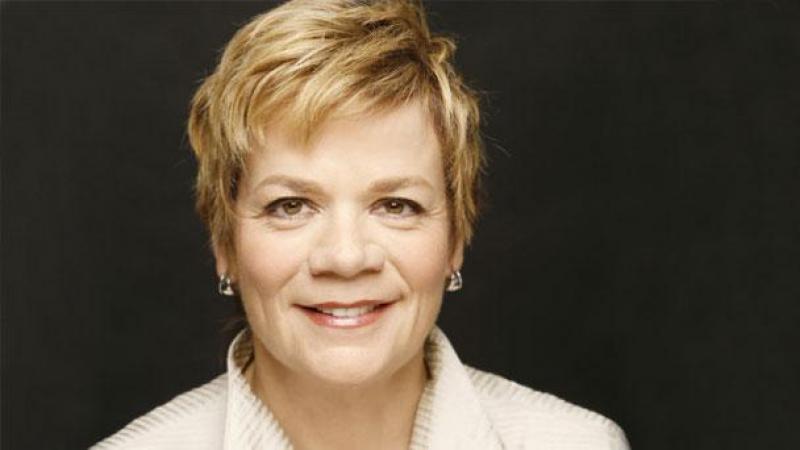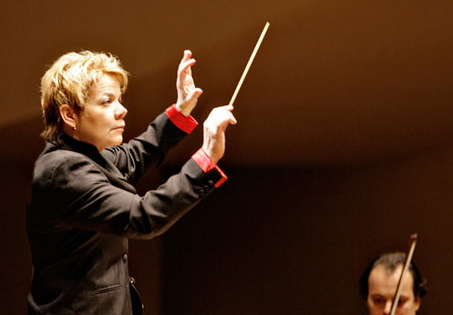Ohlsson, LPO, Alsop, Royal Festival Hall | reviews, news & interviews
Ohlsson, LPO, Alsop, Royal Festival Hall
Ohlsson, LPO, Alsop, Royal Festival Hall
Decidedly muted American roadtrip for the Rest Is Noise Festival

The Southbank Centre’s The Rest is Noise Festival has reached the American leg of its year-long tour through 20th century music, and with it safe musical ground. In the second of three concerts with the LPO, American conductor Marin Alsop showcased the two equally appealing sides of America’s musical history: its cleanly-scrubbed, western classical face in Copland and Ives, and the grubbier, jazz-infused gestures of Joplin and Gershwin.
Alsop (pictured below) is the real deal - a no-nonsense musician with a flair for texture and a real affinity for this generous, rhythmic repertoire. Her little educational segments before each work (a regular feature of the festival) were brisk and funny and resisted the urge to sprawl (ahem, Jurowski). It’s a shame then that the LPO were not on form, tired perhaps from their tough schedule which sees them performing solely 20th century repertoire this season.
Ohlsson is a difficult performer to get wildly excited about
The bold opening clarinet sally of Gershwin’s Rhapsody in Blue failed to shimmy or show any leg, and things went decidedly squiffy as the phrase progressed. Brass ensemble was a contradiction in terms, the big rallentando into the big finale spattered and snagged, and only the ululating, throaty husk of a muted trumpet redeemed things. Soloist Garrick Ohlsson is a supremely undemonstrative pianist which here played neatly into the drama, setting his effortless cool against the strivings of the orchestra. But he’s a difficult performer to get wildly excited about, so self-contained is his approach.
 In Copland’s Piano Concerto it was Ohlsson’s turn to play straight man to his orchestra’s deep jazz cats. The writing of this early work is wilfully unvirtuosic, luring the orchestra into a dialogue on the piano’s own monochrome terms. Jazz is here certainly, but only of the French-cigarette-smoking, existentialist-philosopher-reading variety. There’s some gorgeously idiomatic wind writing, and the LPO’s players turned dramatic ensemble for a sequence of carefully-characterised cameos that supplemented the colours that Copland denies his piano part.
In Copland’s Piano Concerto it was Ohlsson’s turn to play straight man to his orchestra’s deep jazz cats. The writing of this early work is wilfully unvirtuosic, luring the orchestra into a dialogue on the piano’s own monochrome terms. Jazz is here certainly, but only of the French-cigarette-smoking, existentialist-philosopher-reading variety. There’s some gorgeously idiomatic wind writing, and the LPO’s players turned dramatic ensemble for a sequence of carefully-characterised cameos that supplemented the colours that Copland denies his piano part.
Charles Ives’s Three Places In New England is a contemporary classic, its three programmatic movements unfolding as a brightly contrasting triptych of landscape scenes. The filmy textures of the first movement failed to peg themselves successfully to any kind of cumulative narrative, so the arrival at the broadly comic second movement (with its brilliant parody of amateur bandsmen) was less startling that it should have been. Strings felt tentative and underpowered and we missed something of vulgarity in this central section. Only the final movement gained the warmth, the hazy affirmation of Ives’s vision.
Rounding out the programme was a suite taken from Scott Joplin’s opera Treemonisha. It’s a piece well worth staging, but in excerpts (and against such rivals as Copland and Gershwin) it didn’t quite justify its place here. The tunes are broad, the rhythms catchy, but the whole never quite caught that grinning energy that this music needs to sell itself.
A missed opportunity here for the LPO as American ambassadors, but Alsop’s preambles alone would make it worth risking their final concert in this sequence.
rating
Share this article
Add comment
The future of Arts Journalism
You can stop theartsdesk.com closing!
We urgently need financing to survive. Our fundraising drive has thus far raised £49,000 but we need to reach £100,000 or we will be forced to close. Please contribute here: https://gofund.me/c3f6033d
And if you can forward this information to anyone who might assist, we’d be grateful.

Subscribe to theartsdesk.com
Thank you for continuing to read our work on theartsdesk.com. For unlimited access to every article in its entirety, including our archive of more than 15,000 pieces, we're asking for £5 per month or £40 per year. We feel it's a very good deal, and hope you do too.
To take a subscription now simply click here.
And if you're looking for that extra gift for a friend or family member, why not treat them to a theartsdesk.com gift subscription?
more Classical music
 Lammermuir Festival 2025 review - music with soul from the heart of East Lothian
Baroque splendour, and chamber-ensemble drama, amid history-haunted lands
Lammermuir Festival 2025 review - music with soul from the heart of East Lothian
Baroque splendour, and chamber-ensemble drama, amid history-haunted lands
 BBC Proms: Steinbacher, RPO, Petrenko / Sternath, BBCSO, Oramo review - double-bill mixed bag
Young pianist shines in Grieg but Bliss’s portentous cantata disappoints
BBC Proms: Steinbacher, RPO, Petrenko / Sternath, BBCSO, Oramo review - double-bill mixed bag
Young pianist shines in Grieg but Bliss’s portentous cantata disappoints
 theartsdesk at the Lahti Sibelius Festival - early epics by the Finnish master in context
Finnish heroes meet their Austro-German counterparts in breathtaking interpretations
theartsdesk at the Lahti Sibelius Festival - early epics by the Finnish master in context
Finnish heroes meet their Austro-German counterparts in breathtaking interpretations
 Classical CDs: Sleigh rides, pancakes and cigars
Two big boxes, plus new music for brass and a pair of clarinet concertos
Classical CDs: Sleigh rides, pancakes and cigars
Two big boxes, plus new music for brass and a pair of clarinet concertos
 Waley-Cohen, Manchester Camerata, Pether, Whitworth Art Gallery, Manchester review - premiere of no ordinary violin concerto
Images of maternal care inspired by Hepworth and played in a gallery setting
Waley-Cohen, Manchester Camerata, Pether, Whitworth Art Gallery, Manchester review - premiere of no ordinary violin concerto
Images of maternal care inspired by Hepworth and played in a gallery setting
 BBC Proms: Barruk, Norwegian Chamber Orchestra, Kuusisto review - vague incantations, precise laments
First-half mix of Sámi songs and string things falters, but Shostakovich scours the soul
BBC Proms: Barruk, Norwegian Chamber Orchestra, Kuusisto review - vague incantations, precise laments
First-half mix of Sámi songs and string things falters, but Shostakovich scours the soul
 BBC Proms: Alexander’s Feast, Irish Baroque Orchestra, Whelan review - rapturous Handel fills the space
Pure joy, with a touch of introspection, from a great ensemble and three superb soloists
BBC Proms: Alexander’s Feast, Irish Baroque Orchestra, Whelan review - rapturous Handel fills the space
Pure joy, with a touch of introspection, from a great ensemble and three superb soloists
 BBC Proms: Moore, LSO, Bancroft review - the freshness of morning wind and brass
English concert band music...and an outlier
BBC Proms: Moore, LSO, Bancroft review - the freshness of morning wind and brass
English concert band music...and an outlier
 Willis-Sørensen, Ukrainian Freedom Orchestra, Wilson, Cadogan Hall review - romantic resilience
Passion, and polish, from Kyiv's musical warriors
Willis-Sørensen, Ukrainian Freedom Orchestra, Wilson, Cadogan Hall review - romantic resilience
Passion, and polish, from Kyiv's musical warriors
 BBC Proms: Faust, Gewandhausorchester Leipzig, Nelsons review - grace, then grandeur
A great fiddler lightens a dense orchestral palette
BBC Proms: Faust, Gewandhausorchester Leipzig, Nelsons review - grace, then grandeur
A great fiddler lightens a dense orchestral palette
 BBC Proms: Jansen, Royal Concertgebouw Orchestra, Mäkelä review - confirming a phenomenon
Second Prom of a great orchestra and chief conductor in waiting never puts a foot wrong
BBC Proms: Jansen, Royal Concertgebouw Orchestra, Mäkelä review - confirming a phenomenon
Second Prom of a great orchestra and chief conductor in waiting never puts a foot wrong
 BBC Proms: Royal Concertgebouw Orchestra, Mäkelä review - defiantly introverted Mahler 5 gives food for thought
Chief Conductor in Waiting has supple, nuanced chemistry with a great orchestra
BBC Proms: Royal Concertgebouw Orchestra, Mäkelä review - defiantly introverted Mahler 5 gives food for thought
Chief Conductor in Waiting has supple, nuanced chemistry with a great orchestra

Comments
I must have gone to a
"Ohlsson is a difficult
I heard Marin Alsop conduct a